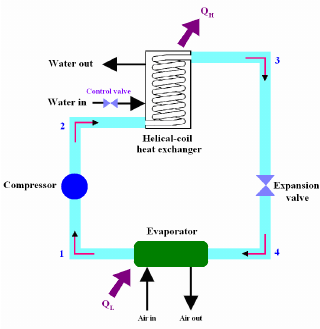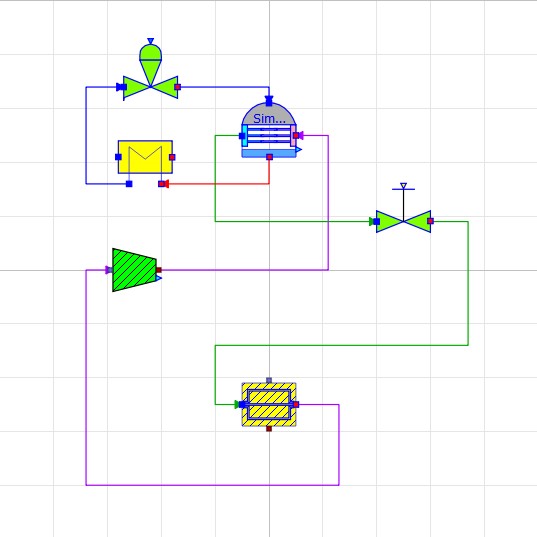Difference between revisions of "Zulian Ismail Dewandanu"
| Line 56: | Line 56: | ||
In the block diagram, there are a total of six components; the aforementioned ones, and the condenser for the water cooling the coolant within the system. As for the parameters, I still have little idea as the tutorial video didn't cover that topic in great detail. | In the block diagram, there are a total of six components; the aforementioned ones, and the condenser for the water cooling the coolant within the system. As for the parameters, I still have little idea as the tutorial video didn't cover that topic in great detail. | ||
| + | |||
| + | == 02/03/2021 == | ||
| + | |||
| + | At the class on Tuesday, we talked a lot about what a system actually is. We agreed that a system is a number of components working in harmony with each other to achieve a goal. Examples of a system can range from a car engine, an organization, even the global economy and politics. | ||
| + | |||
| + | In strictly engineering terms, a system will most likely involve some sort of energy conversion and/or conservation. Like the example of a car engine, chemical energy from the fuel is turned into useful kinetic energy, although at the same time some of that energy is wasted into heat, noise, etc. That is why in a system that us engineers can call perfect, there will be a perfect energy conversion ratio, with an efficiency of 100%. Of course in reality, that is very hard to come by, but that doesn't stop engineers from trying. For example, in Formula 1 racing, engineers have developed systems called MGU-H and MGU-K which conserve heat and kinetic energy, respectively. | ||
| + | |||
| + | In a fluid system, the Bernoulli equation reigns supreme as the ultimate equation for efficiency. | ||
| + | |||
| + | [[File:Bernoli.png|300px|center|]] | ||
| + | |||
| + | From Bernoulli, we know generally how to conserve energy, for example by increasing the fluid velocity and reducing its pressure. These two parameters are actually closely related, as when a fluid has its velocity increased, the pressure almost always drops. Pressure itself can be reimagined as energy/volume, as shown by the following formula: | ||
| + | |||
| + | [[File:Underpressureeq.jpg|450px|center|]] | ||
Revision as of 14:36, 9 March 2021
Full name : Zulian Ismail Dewandanu
NPM : 1706064593
Place, date of birth : Bandung, March 28 1999
Major : Mechanical Engineering
Batch : 2017
I'm a mechanical engineering student of the 8th semester at Universitas Indonesia Faculty of Engineering's International Program. I love engineering topics such as renewable energy, automotive, and aviation. Aside from that, I'm passionate about geopolitics, social issues, and history.
In accordance to my engineering passion in the subjects previously mentioned, I plan to concentrate on aerodynamics, aeronautics, and control systems for my thesis and for my postgraduate studies.
Contents
23/02/2021
Today I'm feeling energized to start the new semester.
About justice, what I feel constitute as 'justice' is the equity of opportunity available for those who are willing to go after and grab those opportunities. For example, free education, cross-subsidy, or an upside down tax-strata are some of the ways the government can help manifest the coveted equal opportunity for their citizens, by way of helping those who are in need to catch up to their more fortunate counterpart in terms of education, economy, etc.
In an engineering sense, equal opportunity can be brought into the scene by developing and integrating low-cost technologies which can be implemented in remote areas. These technologies may include simple electricity generator such as rudimentary water and wind turbines, clean water piping system, telecommunication grid expansion, etc. These technologies, if implemented correctly, can help people who are living in said areas in, for example, studying in the night, or have wider access to information.
Fluid mechanics in my opinion is one of the pillars of mechanical engineering, in addition to manufacturing methods and design. Many topics such as pipe engineering, aerodynamics, pneumatics, etc. have a very tight relationship with fluid mechanics.
Energy is the capacity for an object to do work upon another object. Whereupon asked by a child to explain the concept of energy, in my opinion, you can say something along the lines of "how heavy an object can you lift? How far can you run? Can you go through your activities without feeling hungry?", etc.
The equation "U = Q + W" signifies that for a change in energy within a system, there must be heat either going in or out to the system, and work done to or by the system. This can be related to our daily activity, especially studying, that in order to gain 'energy' (knowledge), we must let ourselves absorb 'energy' around us and do work to gain that 'energy'.
24/02/2021
Yesterday Pak Dai told us to try to understand the following block diagram from Open Modelica:
This diagram is used to represent the core of the workings of a combined cycle powerplant, where the plant essentially increases its efficiency by using leftover heat from one cycle to the other. At this point of the course, I still do not know which cycle is used in this particular case of a power plant.
01/03/2021
OpenModelica is an open-source program developed by the Open Source Modelica Consortium (OSMC). The program is targeted towards industrial professionals as well as academics aiming to model and simulate an environment, be it a system or a process.
Within OpenModelica, exists a program that specifically targets the creation and editing of said simulation/model environment, called OMEdit, or the OpenModelica Connection Editor. This app allows the user to create, edit, and simulate models on the go, as well as plotting the results of modeled system. It is through this app that we are expected to design a system for this course.
First of all, to quickly learn the basics of the app, I tried to find an online video tutorial regarding the use of OMEdit. The following video is the one I picked as it is, in my opinion, the easiest to understand.
Introduction to OMEdit - English
Using the knowledge I gathered from the video, I decided to recreate an air conditioning loop as shown in the following diagram:
As seen in the diagram, there are four components to the system: an evaporator, a compressor, a heat exchanger, and an expansion valve. In adition to the components, there are the connecting pipes, as well as the water in/out for the heat exchanger, complete with the valve.
Through OMEdit, I modeled the system as the following:
In the block diagram, there are a total of six components; the aforementioned ones, and the condenser for the water cooling the coolant within the system. As for the parameters, I still have little idea as the tutorial video didn't cover that topic in great detail.
02/03/2021
At the class on Tuesday, we talked a lot about what a system actually is. We agreed that a system is a number of components working in harmony with each other to achieve a goal. Examples of a system can range from a car engine, an organization, even the global economy and politics.
In strictly engineering terms, a system will most likely involve some sort of energy conversion and/or conservation. Like the example of a car engine, chemical energy from the fuel is turned into useful kinetic energy, although at the same time some of that energy is wasted into heat, noise, etc. That is why in a system that us engineers can call perfect, there will be a perfect energy conversion ratio, with an efficiency of 100%. Of course in reality, that is very hard to come by, but that doesn't stop engineers from trying. For example, in Formula 1 racing, engineers have developed systems called MGU-H and MGU-K which conserve heat and kinetic energy, respectively.
In a fluid system, the Bernoulli equation reigns supreme as the ultimate equation for efficiency.
From Bernoulli, we know generally how to conserve energy, for example by increasing the fluid velocity and reducing its pressure. These two parameters are actually closely related, as when a fluid has its velocity increased, the pressure almost always drops. Pressure itself can be reimagined as energy/volume, as shown by the following formula:




